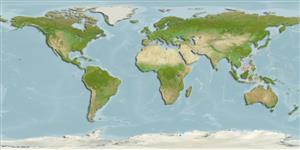Classification / Names
Common names | Synonyms | Catalog of Fishes(genus, species) | ITIS | CoL | WoRMS | Cloffa
Teleostei (teleosts) >
Acropomatiformes (Oceanic basses) >
Synagropidae (Splitfin ocean-basses)
Etymology: parvidens: Name from Latin 'parvus' for small, and 'dens' for tooth, referring to the absence of enlarged canines on dentary (Ref. 116586).
Environment: milieu / climate zone / depth range / distribution range
Ecology
Marine; bathydemersal; depth range 250 - 258 m (Ref. 116586). Tropical
Distribution
Countries | FAO areas | Ecosystems | Occurrences | Point map | Introductions | Faunafri
Western Pacific restricted to the southern Philippines and eastern Indonesia (off southern Sulawesi).
Size / Weight / Age
Maturity: Lm ? range ? - ? cm
Max length : 7.5 cm SL male/unsexed; (Ref. 116586)
Short description
Identification keys | Morphology | Morphometrics
Dorsal spines (total): 10; Dorsal soft rays (total): 9; Anal spines: 2; Anal soft rays: 7. This moderately slender species is distinguished by the following characters: convex dorsal head profile; A II + 7; pectoral-fin rays 15-16, pectoral length 26.2-30.4% SL, reaching anterior tip of anal fin; gill rakers 18-20; pseudobranchial filaments 16-21; first anal-fin pterygiophore long and straight with broad tip and hollow; no canine teeth laterally on dentary; narrow vomer V-shaped with 2-3 rows of granular teeth; palatine broad, with 2 rows granular teeth; ectopterygoid narrow, with 1 row granular teeth. Orbital diameter 10.2-12.1% SL. One or two longitudinal ridges on preopercular lobe; otolith moderately slender (OL:OH = 1.8-1.85) (Ref. 116586).
Life cycle and mating behavior
Maturity | Reproduction | Spawning | Eggs | Fecundity | Larvae
Schwarzhans, W.W. and A.M. Prokofiev, 2017. Reappraisal of Synagrops, Günther, 1887 with rehabilitation and revision of Parascombrops Alcock, 1889 including description of seven new species and two new genera (Perciformes: Acropomatidae). Zootaxa 4260(1):1-74. (Ref. 116586)
IUCN Red List Status (Ref. 130435: Version 2024-2)
Threat to humans
Harmless
Human uses
Tools
Special reports
Download XML
Internet sources
Estimates based on models
Phylogenetic diversity index (Ref.
82804): PD
50 = 0.5001 [Uniqueness, from 0.5 = low to 2.0 = high].
Bayesian length-weight: a=0.00977 (0.00436 - 0.02192), b=3.01 (2.81 - 3.21), in cm total length, based on LWR estimates for this (Sub)family-body shape (Ref.
93245).
Trophic level (Ref.
69278): 3.4 ±0.5 se; based on size and trophs of closest relatives
Fishing Vulnerability (Ref.
59153): Low vulnerability (10 of 100).
